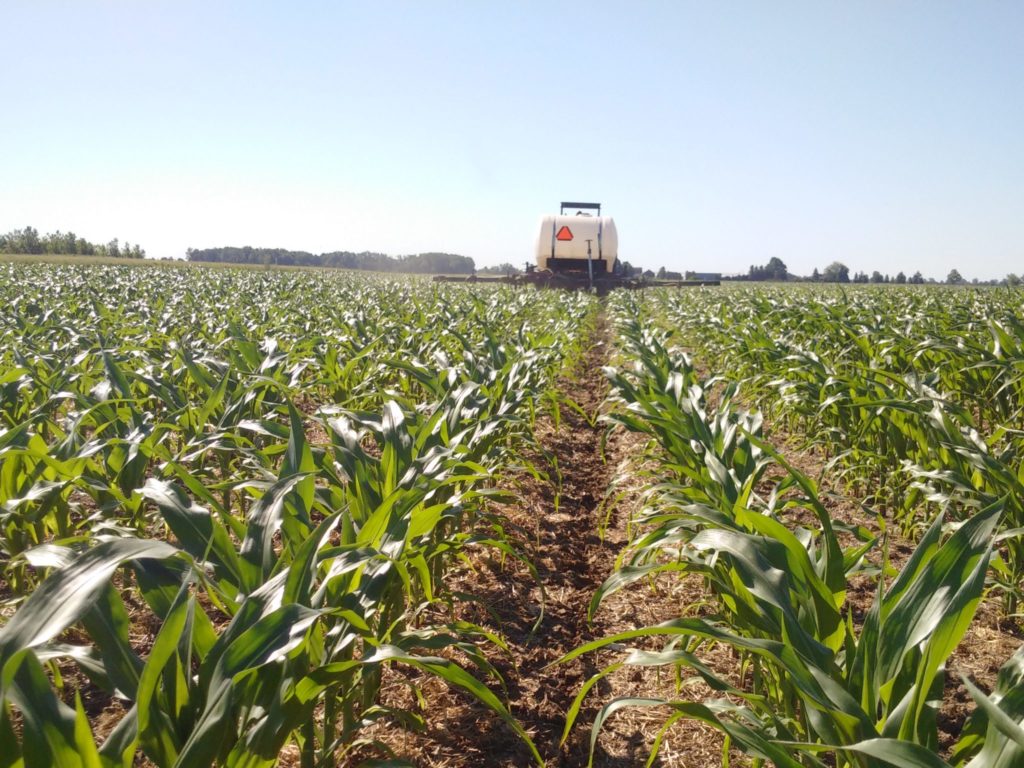Banger, K., C. Wagner-Riddle, B.B. Grant, W.N. Smith, C. Drury and J. Yang. 2020. Modifying fertilizer rate and application method reduces environmental nitrogen losses and increases corn yield in Ontario. Science of The Total Environment 722: 137851. doi:10.1016/j.scitotenv.2020.137851
Research summary by Kamal Banger and Cameron Ogilvie
Key messages
- This study simulated how different 4R fertilizer management practices influence nitrous oxide (N2O) emissions and other nitrogen losses in Ontario
- Using a combination of practices – injecting, adding inhibitors, split-applying, and adjusting rates – reduced N2O emissions by up to 50% while minimizing other nitrogen losses
Nitrogen fertilizer in corn production is an important driver of nitrous oxide (N2O) emissions which contribute to climate warming and ozone layer destruction. To reduce emissions, the fertilizer industry recommends implementing 4R fertilizer management practices (Right source, Right rate, Right time and Right place). But these 4R practices affect not only N2O emissions but also nitrate (NO3–) leaching or ammonia (NH3) volatilization losses. For example, urease inhibitors can reduce NH3 losses, but they can also increase N2O emissions by keeping more soil nitrogen available to be lost through denitrification. Therefore, a combination of two or more practices may be best for reducing N2O emissions and increasing nitrogen use efficiency.
In this study, researchers used a computer simulation known as the Denitrification-Decomposition (DNDC) model to estimate how different 4R strategies would affect N2O emissions in Ontario. To do this, they simulated corn yield and environmental nitrogen losses (NH3, NO3− and N2O) in response to 11 fertilizer management scenarios across the 270 corn production regions of Ontario over a 30-year time period.
What they found
The analysis suggests that a combination of practices has the greatest potential to reduce nitrogen losses from corn production in Ontario. By injecting fertilizer, adding inhibitors, split-applying nitrogen at planting and sidedress, and adjusting fertilizer rates, N2O emissions per bushel of grain were reduced by as much as 50% while also minimizing other nitrogen losses. This was compared to a baseline scenario that assumed 90% of Ontario corn growers currently inject all their fertilizer nitrogen at planting and 10% of them broadcast without incorporating. Adjusting rates and using a split application, or adjusting rates and applying an inhibitor with nitrogen injected at planting were the next most effective scenarios.
Why it matters
From farmer’s standpoint, while split applying, injecting, and using inhibitors with nitrogen fertilizer applications all come with additional costs, they can also increase corn yields by 3-4% and reduce fertilizer requirements. For policymakers, this analysis highlights that developing policies that focus on improving fertilizer nitrogen placement, using inhibitors, and/or adjusting the time of application along with the fertilizer rate can significantly reduce the N2O footprint of Ontario corn production.
How they did it
The DNDC model is a computer simulation that can predict crop yield, as well as carbon and nitrogen cycling in agroecosystems. In order to run the simulation, researchers provide information such as daily weather data, soil type, and crop management practices. The simulation was run for 11 fertilizer management scenarios while keeping all other inputs constant. The scenario options were: 1) broadcasting fertilizer on the soil surface at planting, 2) injecting fertilizer 10 cm below the surface at planting, 3) split applying some fertilizer at planting and the rest at sidedress, both by injection, 4) using inhibitors, and 5) adjusting fertilizer rates based on changes in crop requirements from using practices 2-4. All other scenarios were compared against baseline scenario which assumed that 90% of Ontario corn growers currently inject all their fertilizer nitrogen at planting and do not use inhibitors, and 10% of growers will broadcast their fertilizer.


